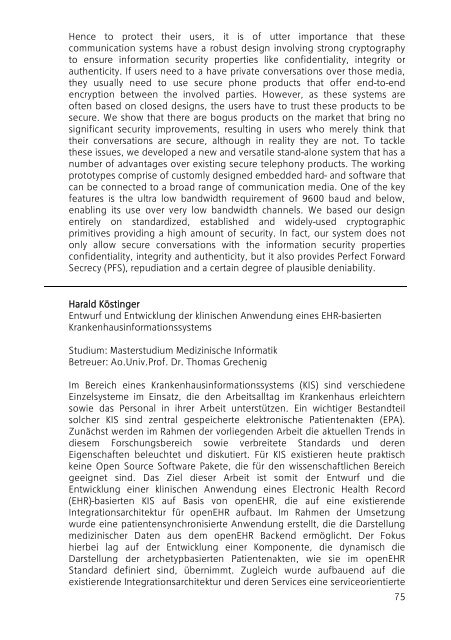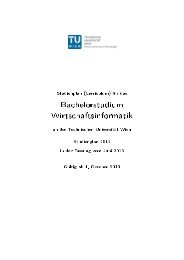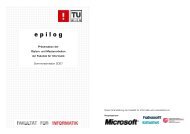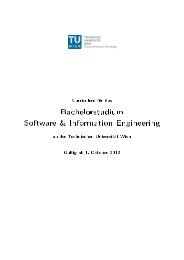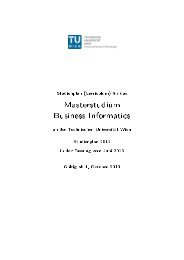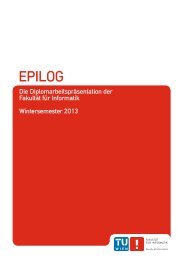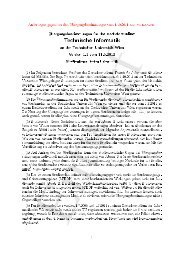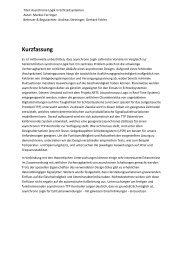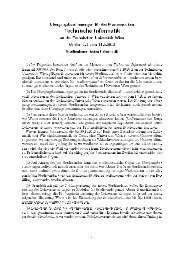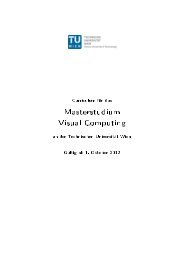Abstract-Band - Fakultät für Informatik, TU Wien - Technische ...
Abstract-Band - Fakultät für Informatik, TU Wien - Technische ...
Abstract-Band - Fakultät für Informatik, TU Wien - Technische ...
Sie wollen auch ein ePaper? Erhöhen Sie die Reichweite Ihrer Titel.
YUMPU macht aus Druck-PDFs automatisch weboptimierte ePaper, die Google liebt.
Hence to protect their users, it is of utter importance that these<br />
communication systems have a robust design involving strong cryptography<br />
to ensure information security properties like confidentiality, integrity or<br />
authenticity. If users need to a have private conversations over those media,<br />
they usually need to use secure phone products that offer end-to-end<br />
encryption between the involved parties. However, as these systems are<br />
often based on closed designs, the users have to trust these products to be<br />
secure. We show that there are bogus products on the market that bring no<br />
significant security improvements, resulting in users who merely think that<br />
their conversations are secure, although in reality they are not. To tackle<br />
these issues, we developed a new and versatile stand-alone system that has a<br />
number of advantages over existing secure telephony products. The working<br />
prototypes comprise of customly designed embedded hard- and software that<br />
can be connected to a broad range of communication media. One of the key<br />
features is the ultra low bandwidth requirement of 9600 baud and below,<br />
enabling its use over very low bandwidth channels. We based our design<br />
entirely on standardized, established and widely-used cryptographic<br />
primitives providing a high amount of security. In fact, our system does not<br />
only allow secure conversations with the information security properties<br />
confidentiality, integrity and authenticity, but it also provides Perfect Forward<br />
Secrecy (PFS), repudiation and a certain degree of plausible deniability.<br />
Harald Köstinger<br />
Entwurf und Entwicklung der klinischen Anwendung eines EHR-basierten<br />
Krankenhausinformationssystems<br />
Studium: Masterstudium Medizinische <strong>Informatik</strong><br />
Betreuer: Ao.Univ.Prof. Dr. Thomas Grechenig<br />
Im Bereich eines Krankenhausinformationssystems (KIS) sind verschiedene<br />
Einzelsysteme im Einsatz, die den Arbeitsalltag im Krankenhaus erleichtern<br />
sowie das Personal in ihrer Arbeit unterstützen. Ein wichtiger Bestandteil<br />
solcher KIS sind zentral gespeicherte elektronische Patientenakten (EPA).<br />
Zunächst werden im Rahmen der vorliegenden Arbeit die aktuellen Trends in<br />
diesem Forschungsbereich sowie verbreitete Standards und deren<br />
Eigenschaften beleuchtet und diskutiert. Für KIS existieren heute praktisch<br />
keine Open Source Software Pakete, die <strong>für</strong> den wissenschaftlichen Bereich<br />
geeignet sind. Das Ziel dieser Arbeit ist somit der Entwurf und die<br />
Entwicklung einer klinischen Anwendung eines Electronic Health Record<br />
(EHR)-basierten KIS auf Basis von openEHR, die auf eine existierende<br />
Integrationsarchitektur <strong>für</strong> openEHR aufbaut. Im Rahmen der Umsetzung<br />
wurde eine patientensynchronisierte Anwendung erstellt, die die Darstellung<br />
medizinischer Daten aus dem openEHR Backend ermöglicht. Der Fokus<br />
hierbei lag auf der Entwicklung einer Komponente, die dynamisch die<br />
Darstellung der archetypbasierten Patientenakten, wie sie im openEHR<br />
Standard definiert sind, übernimmt. Zugleich wurde aufbauend auf die<br />
existierende Integrationsarchitektur und deren Services eine serviceorientierte<br />
75


